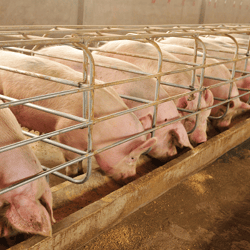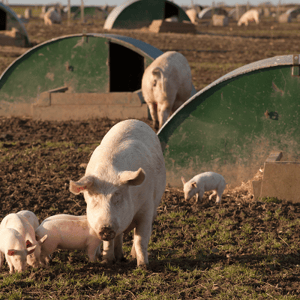- Posted by Anitox
How Technology Could Predict Future PEDv Outbreaks
Porcine Epidemic Diarrhea virus (PEDv) has had a dramatic impact on the U.S. swine industry since it first appeared in the United States in 2013. By some estimates, PEDv has cost over $1.8 billion in losses, led to the culling of 8 million pigs, and touched approximately 50% of all sow farms. Its impact has been felt across the globe, with cases recently being confirmed in Germany, the European Union’s second-largest pork producing country.
While improved biosecurity measures offer greater protection against PEDv than we had a decade ago, the ability to accurately forecast the virus’ spread between farms will enhance our prevention and response efforts even further.
While improved biosecurity measures offer greater protection against PEDv than we had a decade ago, the ability to accurately forecast the virus’ spread between farms will enhance our prevention and response efforts even further.
Speaking at an Anitox sponsored webinar on the subject, leading researcher Dr. Gustavo Machado explains: the research that my team has done on this topic has two primary aims: to enhance our understanding of the interacting variables that contribute to the circulation of PEDv between farms, and to quantify the weekly risk of PED outbreaks in sow farms based on animal movements and the likelihood of exposure from neighboring farms. In order to explore these topics, we have taken two approaches: machine learning algorithms and a mathematical modeling.
Before building either a mathematical model or a machine learning algorithm for forecasting the virus’ spread between farms we must first establish the primary drivers of virus transmission: animal movement, fomites, feed, personnel movement, and spatial proximity.
 In our machine learning research, my team approached the issue by assuming that the entire process of PEDv transmission takes place within a 10-kilometer radius of the sow farm at hand. Instead of focusing on specific farm risk, we focused on specific risk neighborhoods, which enables our approach to capture the effects of wildlife and geography that other approaches sometimes miss. This model takes into account the number of animals and number of batches in the neighborhood along with intercept variables including geographical and weather data along with hog density per square kilometer. Using machine learning algorithms with one year of valid data, we were able to predict the neighborhoods in which transmission would take place one week ahead of time with 85.14% accuracy.
In our machine learning research, my team approached the issue by assuming that the entire process of PEDv transmission takes place within a 10-kilometer radius of the sow farm at hand. Instead of focusing on specific farm risk, we focused on specific risk neighborhoods, which enables our approach to capture the effects of wildlife and geography that other approaches sometimes miss. This model takes into account the number of animals and number of batches in the neighborhood along with intercept variables including geographical and weather data along with hog density per square kilometer. Using machine learning algorithms with one year of valid data, we were able to predict the neighborhoods in which transmission would take place one week ahead of time with 85.14% accuracy.
Building on this research, our team of researchers led by Dr. Jason Galvis built a mathematical model that sought to quantify the contribution of the main PEDv transmission routes along with the impact of disease control interventions in the projected “next week” risk of spread.
Preliminary results from this new mathematical model are very promising. We were able to predict “next week” risk of spread with 95.3% accuracy. Using this data, we were also able to record evidence that virus exposure (feedback) interventions reduced transmission incidents by 65%.
Going forward, there may be practical applications for this research, such as regional efforts to apply these models to understand and control transmission risk. Of course, any such effort would require extensive cooperation across the swine industry.
In future research, we hope to study both intra-farm transmission and the role of feed delivery and animal pickup on inter-farm transmission, in order to gain a fuller understanding of transmission methods and dynamics.
Where are we today?
By Dr. Kurt Richardson
While Dr. Machado and his team have been modeling risk, Dee and Pasick have confirmed that feed matrices with and without animal proteins have the potential to sustain PEDv for 37 days, and go on to lead directly to infection. The industry has control tools at its disposal today to effectively mitigate against this risk. Unlike traditional organic acids, both Termin-8 (formaldehyde) and Finio (a patent-protected formulation of novel phytochemicals and carboxylic acids) control PEDv in feed and provide residual protection against recontamination. I have no doubt Dr. Machado’s work will ultimately mean that our swine industry can more effectively manage the risk of outbreak; thankfully we have the resources to hand today to ensure that feed need not be the trigger for a loss of herds and livelihoods in the meantime.
Sources:
● Machado, G., Vilalta, C., Recamonde-Mendoza, M., Corzo, C., Torremorell, M., Perez, A., & VanderWaal, K. (2019). Identifying outbreaks of Porcine Epidemic Diarrhea virus through animal movements and spatial neighborhoods Scientific Reports, 9(1)
● Machado, G.; Galvis, J., Jones, C., Corzo, C., Prada, J. Porcine Epidemic Diarrhea virus spatial dynamics: a modelling comparison. Submitted to Transboundary and Emerging Diseases.


.png?width=514&height=300&name=welcome%20to%20ippe%20marketplace%20(2).png)